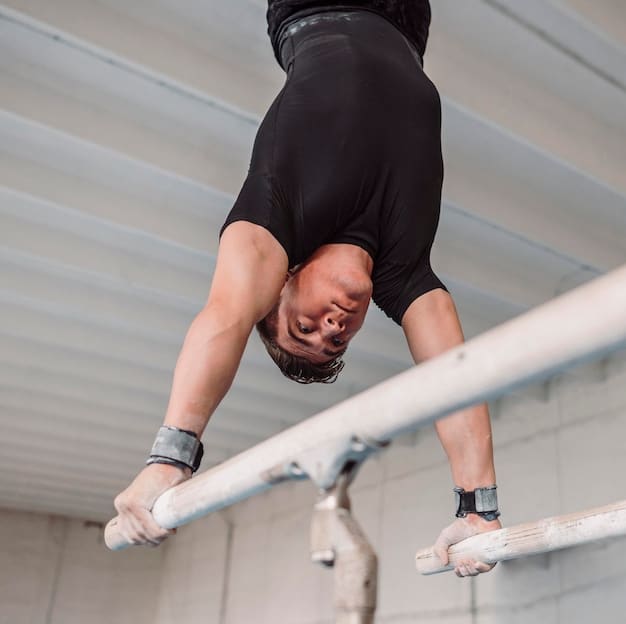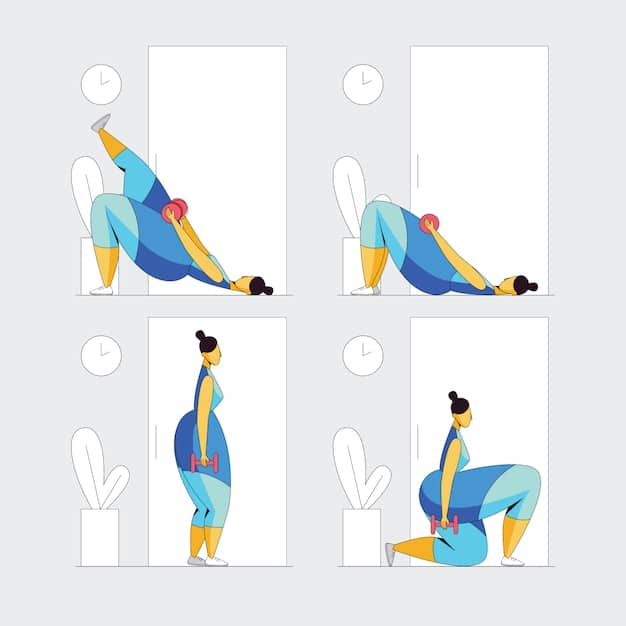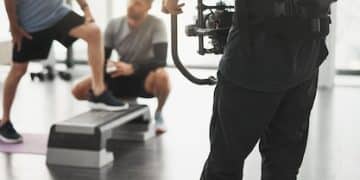Master Calisthenics: Beginner-to-Advanced Bodyweight Mastery

Achieving bodyweight mastery through calisthenics involves a structured progression from fundamental exercises to advanced skills, emphasizing proper form, consistent practice, and progressive overload to build functional strength and exceptional body control.
Embarking on a journey to **master calisthenics: the beginner-to-advanced routine for bodyweight mastery** offers a unique path to fitness, one that sculpts the body using only its own weight. This discipline transcends mere strength; it cultivates unparalleled body control, agility, and a profound connection between mind and muscle. If you’re ready to redefine your physical limits and build a foundation of functional strength, then welcome to the world of calisthenics, where your body becomes your ultimate gym.
The Foundations of Calisthenics: Building a Solid Base
The journey to mastering calisthenics begins not with flashy aerial movements, but with a robust understanding of fundamental body mechanics and basic exercises. Without a strong foundation, advanced skills are not only unattainable but also carry a significant risk of injury. This initial phase focuses on developing core strength, joint stability, and the muscular endurance necessary for progression.
Before diving into complex routines, it’s crucial to understand the principles of progressive overload within calisthenics. Unlike weightlifting where you add plates, calisthenics progresses by modifying leverage, increasing repetitions, slowing down movements, or advancing to more challenging exercise variations. This systematic approach ensures continuous adaptation and growth, preventing plateaus and maintaining motivation.
Understanding Core Principles
Success in calisthenics hinges on mastering a few non-negotiable principles. These aren’t just guidelines; they are the bedrock upon which all advanced skills are built. Neglecting them can lead to stagnation, injury, and frustration.
- Form over everything: Proper form is paramount. Incorrect technique not only diminishes the exercise’s effectiveness but also drastically increases the risk of injury. Every repetition should be executed with precision, focusing on muscle engagement and controlled movements.
- Consistency is key: Regular training, even if it’s just 3-4 times a week, yields far better results than sporadic, intense sessions. The body adapts to consistent stimuli, making regular practice indispensable for progress.
- Listen to your body: Rest and recovery are as important as the training itself. Overtraining can lead to fatigue, decreased performance, and injury. Understanding when to push and when to rest is a skill developed over time.
- Progressive overload: To continue gaining strength and skill, you must continually challenge your muscles beyond their current capacity. This can mean more reps, more sets, harder variations, or shorter rest times.
Beginning with fundamental exercises such as push-ups, squats, planks, and basic bodyweight rows (if access to a low bar is available) establishes the necessary strength and coordination. These movements engage multiple muscle groups, fostering functional strength that translates directly to daily activities and more complex calisthenics skills. Each exercise should be practiced diligently, aiming for impeccable form before increasing volume or difficulty.
Building a solid base in calisthenics involves more than just physical repetition; it requires mental fortitude and patience. Recognize that progress is not always linear, and some days will be more challenging than others. Embrace the process, celebrate small victories, and remain committed to the foundational work. This initial phase, though seemingly simple, lays the groundwork for a lifetime of bodyweight mastery.
Intermediate Progression: Bridging the Gap to Advanced Skills
Once the foundational bodyweight exercises are mastered with good form and sufficient volume, it’s time to transition into the intermediate phase of calisthenics. This stage is exciting as it introduces more dynamic and challenging variations that serve as direct prerequisites for advanced skills. The focus shifts from simply building strength to refining body control, balance, and muscular endurance through increasingly complex movements.
The core of intermediate progression lies in understanding how to manipulate leverage and incorporate single-limb variations to increase difficulty. For instance, moving from standard push-ups to incline push-ups, then decline push-ups, and finally to one-arm push-up progressions represents a classic example of calisthenics progressive overload. Each step builds on the previous one, strengthening specific muscle groups and neuromuscular pathways.
Key Intermediate Exercises and Progressions
At this stage, you’ll begin to integrate exercises that directly lead into iconic calisthenics moves. The emphasis remains on quality over quantity, ensuring each rep contributes meaningfully to your overall strength and skill development.
- Pull-up Variations: Beyond the standard pull-up, explore archer pull-ups, L-sit pull-ups, and eventually one-arm pull-up negatives. These variations build the immense back and biceps strength required for advanced pulling movements like the front lever.
- Push-up and Dip Progressions: Progress from decline push-ups to pseudo planche push-ups, and from basic dips to Korean dips or weighted dips. These are crucial for developing the shoulder and triceps strength needed for skills like the planche.
- Leg and Core Integration: While less flashy, single-leg squats (pistol squats), Nordic curls, and various hanging leg raises are vital. They enhance lower body strength, balance, and core stability, which underpin nearly every calisthenics skill.
- Handstand Practice: Begin with wall handstands (chest to wall for better form feedback) and gradually work on handstand holds. This develops shoulder strength, wrist stability, and the crucial balance needed for handstand push-ups and eventually freestanding handstands.
At this intermediate level, it’s common to encounter plateaus. When this happens, revisit your nutrition, ensure adequate sleep, and consider deload weeks to allow your body to fully recover and adapt. Incorporating active recovery, such as light stretching or foam rolling, can also aid in muscle repair and flexibility, both essential for navigating the physical demands of more advanced movements.
Furthermore, the psychological aspect of training becomes more pronounced. Intermediate skills often require greater mental focus and resilience. Visualizing successful execution and breaking down complex movements into smaller, manageable steps can be incredibly beneficial. This phase is a testament to perseverance, as you refine your technique and build the specific strength necessary to bridge the gap between beginner and truly advanced calisthenics feats.
Advanced Calisthenics: Mastering Iconic Bodyweight Feats
Reaching the advanced stage of calisthenics is a significant achievement, marking a commitment to unparalleled body control and strength. This is where the iconic skills reside: the planche, the front lever, the human flag, and the one-arm pull-up. These movements require years of dedicated training, a profound understanding of leverage, and an exceptional degree of strength-to-weight ratio.
The progression to advanced skills is less about adding more reps and more about perfecting the intricate mechanics of each movement. Each skill builds upon the cumulative strength, balance, and proprioception developed during the foundational and intermediate phases. Patience and meticulous attention to detail become even more critical, as small adjustments in body positioning can make a dramatic difference in execution.

Signature Advanced Calisthenics Skills
Achieving these movements is not a linear path. It involves consistent practice of specific progressions, often spending months or even years working on individual elements before the full skill is unlocked. This journey is a marathon, not a sprint.
- The Planche: This involves holding the entire body parallel to the ground with only the hands supporting your weight. Progressions include tucked planche, advanced tucked planche, straddle planche, and finally the full planche. It demands immense wrist, forearm, shoulder, and core strength.
- The Front Lever: Holding your body horizontally parallel to the ground while hanging from a bar. Progressions move from tucked front lever to advanced tucked, one-leg straight, straddle, and full front lever. It primarily works the lats, core, and back muscles.
- The Human Flag: A spectacular display of strength where the body is held horizontally from a vertical pole or bar. This skill requires extraordinary oblique, shoulder, and core strength. Progressions start with tucked flag, one-leg flag, and straddle flag.
- One-Arm Pull-up (OAPU) and One-Arm Chin-up (OACU): These are ultimate tests of unilateral pulling strength. Building up to these involves extensive work on assisted one-arm pull-ups, uneven pull-ups, and various types of negatives.
Beyond the brute strength, advanced calisthenics demands exceptional mobility and flexibility. Tight shoulders, hips, or wrists can impede progress and increase injury risk. Incorporating regular stretching, dynamic warm-ups, and mobility drills into your routine is non-negotiable at this level. This holistic approach ensures your body is not just strong, but also resilient and adaptable.
The mental aspect of advanced calisthenics cannot be overstated. You will face significant challenges and periods of slow progress. Cultivating a growth mindset, embracing failure as a learning opportunity, and staying intrinsically motivated are crucial. Expert calisthenics practitioners often emphasize the journey and the discipline it instills, rather than solely focusing on the end goal of a specific skill. The pursuit of mastery itself becomes the reward.
Structuring Your Calisthenics Routine for Optimal Growth
A well-structured calisthenics routine is essential for consistent progress, injury prevention, and long-term adherence. It moves beyond random workouts and embraces a systematic approach, often divided into phases that prioritize different aspects of strength and skill development. Understanding how to organize your training week, sets, and repetitions is key to unlocking your full potential.
The principles of periodization, commonly applied in traditional strength training, are equally relevant in calisthenics. This involves varying the training stimulus over time to prevent stagnation and facilitate continuous adaptation. For beginners, a full-body routine performed 3-4 times a week is often most effective, allowing for skill acquisition and muscular development. As you advance, routines may become more specialized, focusing on specific muscle groups or skill blocks.
Designing Effective Training Sessions
An effective calisthenics session typically includes a warm-up, skill practice, strength work, and a cool-down. The exact structure and content will depend on your current level and specific goals.
- The Warm-up: Essential for preparing the body for exercise, a warm-up should include light cardio, dynamic stretches, and joint rotations (especially wrists and shoulders). This increases blood flow, enhances flexibility, and reduces injury risk.
- Skill Practice: This is where you work on your target skills (e.g., handstand holds, lever progressions). Dedicate 15-20 minutes at the beginning of your session, when your nervous system is fresh, to focused, low-repetition work on these challenging movements.
- Strength Work: The main portion of your workout, focusing on compound bodyweight exercises. Aim for 3-5 sets of 5-12 repetitions for strength, or higher reps (12-20+) for endurance, depending on your goals and the exercise. Vary your exercise selection to ensure balanced development.
- Cool-down and Flexibility: Conclude with static stretches held for 20-30 seconds, targeting the major muscle groups worked during the session. This aids recovery and improves overall flexibility, crucial for advanced movements.
Consider implementing a split routine as you progress, such as push/pull/legs or upper/lower splits, to allow for more recovery for individual muscle groups while maintaining training frequency. For instance, a “push” day might focus on planche progressions, handstand push-ups, and dips, while a “pull” day would cover front lever progressions, pull-ups, and rows. Integrating active recovery days or lighter mobility work on non-training days can further enhance preparedness and prevent burnout.
Tracking your progress is also vital. Keep a training log where you record exercises, sets, reps, and any specific notes on form or difficulty. This allows you to objectively see your improvements, identify areas needing more work, and adjust your routine as needed. Remember, the ‘perfect’ routine is one that you can consistently adhere to and that continually challenges you just enough to stimulate growth without leading to overtraining. Flexibility in your plan, based on how your body feels, is a sign of an experienced practitioner.
Nutrition and Recovery: Fueling Your Bodyweight Mastery Journey
While the focus of calisthenics is often on training techniques and skill progression, the importance of nutrition and recovery cannot be overstated. They are the twin pillars supporting every session, every progression, and ultimately, every achievement in your bodyweight mastery journey. Without proper fuel and adequate rest, even the most meticulously planned training routine will yield suboptimal results and increase the risk of injury.
Think of your body as a high-performance vehicle. You wouldn’t put low-quality fuel into a sports car and expect it to perform optimally, nor would you drive it continuously without maintenance. Similarly, your body requires premium fuel (nutrient-dense foods) and regular maintenance (sleep, active recovery, stress management) to sustain the demands of calisthenics training and facilitate muscle repair and growth.
Essential Components of Nutrition and Recovery
Your dietary choices directly impact your energy levels, recovery capabilities, and overall body composition, which is particularly relevant in calisthenics where strength-to-weight ratio is critical. Recovery, on the other hand, is when your body rebuilds and adapts, becoming stronger and more skilled.
-
Macronutrients:
- Proteins: Crucial for muscle repair and growth. Aim for lean sources like chicken, fish, eggs, legumes, and protein supplements if needed.
- Carbohydrates: Your primary energy source. Choose complex carbs like whole grains, fruits, and vegetables for sustained energy.
- Fats: Essential for hormone production and nutrient absorption. Prioritize healthy fats from avocados, nuts, seeds, and olive oil.
- Micronutrients: Don’t overlook vitamins and minerals found in a diverse diet of fruits, vegetables, and whole foods. These play vital roles in energy metabolism, immune function, and overall health.
- Hydration: Water is fundamental for every bodily function, including nutrient transport and temperature regulation. Ensure consistent water intake throughout the day.
- Sleep: The most potent recovery tool. Aim for 7-9 hours of quality sleep per night. During deep sleep, growth hormones are released, muscle repair occurs, and the nervous system recovers.
- Active Recovery and Mobility: Light activities like walking, foam rolling, and stretching improve blood flow, reduce muscle soreness, and maintain flexibility, aiding in overall recovery and injury prevention.
Moreover, consider the timing of your meals. Eating a balanced meal or snack containing protein and carbohydrates within an hour or two after your workout can significantly boost muscle recovery and glycogen replenishment. Pre-workout nutrition should focus on easily digestible carbohydrates to provide energy without causing digestive discomfort.
Stress management is another often-overlooked aspect of recovery. Chronic stress elevates cortisol levels, which can hinder muscle growth and increase fat storage. Incorporating mindfulness, meditation, or simply dedicating time to hobbies can significantly mitigate stress and thereby enhance your physical performance and recovery. Embrace a holistic view of your health; what you do outside of your training sessions is just as important as what you do during them.
Overcoming Plateaus and Preventing Injuries in Calisthenics
Every calisthenics practitioner, from novice to master, will inevitably encounter plateaus and face the risk of injury. These are not signs of failure but rather inherent challenges in any demanding physical discipline. Learning to navigate these obstacles effectively is crucial for long-term progress and a sustainable training journey. Resilience, adaptability, and a proactive approach to body care are paramount.
Plateaus, defined as periods where progress stalls despite consistent effort, often indicate that your body has adapted to the current training stimulus. Injuries, while sometimes acute, frequently stem from overuse, poor form, or insufficient recovery. Recognizing the signs of both and implementing corrective strategies is key to breaking through barriers and staying healthy.
Strategies for Continuous Progress and Injury Prevention
A multi-faceted approach combines intelligent training modifications with dedicated self-care practices. Simply pushing harder through a plateau or ignoring nagging pain is often counterproductive.
-
Vary Your Training:
- Exercise Selection: Introduce new variations of exercises to challenge muscles from different angles (e.g., wide grip pull-ups vs. close grip).
- Rep/Set Schemes: Change up your volume and intensity. If you’ve been doing 3 sets of 10, try 5 sets of 5 with a harder variation, or 2 sets to failure on an easier variation.
- Tempo Training: Slow down the eccentric (lowering) phase of your movements or add pauses at specific points to increase time under tension.
- Deload Weeks: Periodically reduce your training volume and intensity (e.g., 50% of usual reps/sets) for a week. This allows your body to fully recover and supercompensate.
- Address Weak Links: Identify any muscle imbalances or areas of weakness. For instance, if your push-up progress stalls, your triceps might be a weak link, requiring supplementary triceps extensions.
- Perfect Your Form: Even at advanced levels, form can degrade under fatigue. Filming yourself or having a coach observe your technique can reveal subtle flaws that are hindering progress or increasing injury risk.
- Prioritize Recovery: Revisit your sleep, nutrition, and hydration. These foundational elements are often the first to suffer when plateaus hit or injuries occur.
- Active Mobility and Prehab: Incorporate daily mobility drills and prehabilitation exercises (e.g., rotator cuff strengthening, wrist conditioning) to enhance joint health and prevent common calisthenics injuries like elbow tendinitis or shoulder impingement.
- Listen to Your Body: Differentiate between muscle soreness and persistent pain. If a movement causes sharp or unusual pain, stop immediately and assess. Don’t push through pain that indicates potential injury.
When injuries do occur, seek professional advice. A physical therapist or sports medicine doctor can provide an accurate diagnosis and a rehabilitation plan. Returning to training too soon or without adequate rehabilitation is a common mistake that leads to chronic issues. Patience during recovery is just as important as patience during progression. By smartly navigating plateaus and prioritizing injury prevention, your calisthenics journey can be both rewarding and sustainable for years to come.

The Mental Game of Calisthenics: Cultivating Discipline and Resilience
While calisthenics is undeniably a physical discipline, its mastery extends far beyond muscular strength and technical proficiency. The mental game—the cultivation of discipline, resilience, patience, and self-belief—is equally, if not more, critical to long-term success. The path from beginner to advanced bodyweight mastery is fraught with challenges, plateaus, and moments of self-doubt. It is the mental fortitude to persist through these difficulties that truly defines a calisthenics master.
Unlike many athletic pursuits, calisthenics often involves a highly individualized journey. There are no teams or opponents in the traditional sense; your primary challenge is yourself. This internal battle demands immense self-motivation and a strong mind-body connection. Overcoming the physical discomfort of a challenging set or the frustration of a stalled progression requires a profound inner strength that is honed with every workout.
Developing a Winning Mindset
Cultivating a robust mental approach involves several key strategies that can transform your training from a chore into a deeply rewarding practice. These elements build on each other, creating a cycle of positive reinforcement.
- Set Realistic Goals: Break down large, intimidating skills (like a full planche) into smaller, achievable steps (tucked planche, advanced tucked planche). Celebrating each mini-victory fuels motivation and prevents overwhelm.
- Embrace the Process: Focus on the journey of improvement, not just the destination skill. Enjoy the sensation of getting stronger, the camaraderie of the calisthenics community, and the personal discipline it instills.
- Visualize Success: Before attempting a difficult skill or set, mentally rehearse the movement with perfect form. Visualization can enhance neuromuscular pathways and boost confidence.
- Learn from Failure: Every failed attempt is a learning opportunity. Analyze what went wrong, adapt your approach, and try again. Resilience isn’t about never falling, but about always getting back up.
- Practice Patience: Calisthenics progression, especially at advanced levels, is slow. Understand that mastery takes time, often years. Resist the urge to rush, which can lead to injury and burnout.
- Mindful Training: Be fully present during your workouts. Focus on muscle activation, breathing, and body position. This improves form, deepens muscle connection, and helps you listen to your body’s signals.
- Positive Self-Talk: Challenge negative thoughts and replace them with empowering affirmations. Believe in your ability to improve, even on tough days. Your inner dialogue significantly impacts your performance.
The lessons learned in the pursuit of calisthenics mastery—discipline, perseverance, patience, and a methodical approach to problem-solving—are transferable far beyond the gym. They become invaluable tools for navigating life’s challenges. In essence, while you train your body to perform incredible feats, you are simultaneously forging a stronger, more resilient mind. This profound interplay between physical and mental development is perhaps the most significant reward of bodyweight mastery.
| Key Aspect | Brief Description |
|---|---|
| 💪 Foundation | Mastering basic movements with perfect form is crucial for safety and progress. |
| 📈 Progression | Systematically increase difficulty through leverage, volume, or exercise variations. |
| 🥑 Recovery | Nutrition, sleep, and active rest are as vital as training for muscle repair and growth. |
| 🧘♂️ Mindset | Patience, discipline, and resilience are key to overcoming plateaus and achieving advanced skills. |
Frequently asked questions about calisthenics mastery
▼
Mastering calisthenics is a journey, not a destination, varying greatly by individual. While foundational strength can be built in months, achieving iconic skills like the planche or front lever often takes years of consistent, dedicated practice and meticulous attention to progression, nutrition, and recovery. Patience and persistence are key.
▼
While many calisthenics exercises require no equipment at all (push-ups, squats, planks), a pull-up bar is highly recommended for comprehensive upper body development. Resistance bands and parallettes can also be very beneficial for assisting or progressing movements, but are not strictly necessary for beginners. Consistency is more important than gear.
▼
Absolutely. Calisthenics, especially with proper progressive overload, can build substantial muscle mass, particularly in the upper body and core. The focus on compound movements and high time under tension effectively stimulates hypertrophy. Advanced practitioners often display impressive physiques that are both strong and aesthetically pleasing, built purely with bodyweight.
▼
Progressive overload in calisthenics means continually increasing the demands placed on your muscles to stimulate growth. This is achieved by increasing reps/sets, decreasing rest, improving exercise form, or, most commonly, advancing to harder variations of an exercise (e.g., from push-ups to decline push-ups to planche push-ups). It ensures sustainable progress.
▼
Nutrition is critically important for calisthenics. It provides the energy for intense workouts, the building blocks for muscle repair and growth, and supports overall recovery. A diet rich in protein, complex carbohydrates, and healthy fats, alongside adequate hydration, is essential to maximize performance, facilitate adaptation, and prevent fatigue or injury. It fuels your mastery.
Conclusion
The journey to **master calisthenics: the beginner-to-advanced routine for bodyweight mastery** is a profound testament to what the human body can achieve with dedication and intelligent training. It’s a path that transcends fleeting fitness trends, offering a sustainable, rewarding approach to strength, control, and holistic well-being. From diligently perfecting foundational movements to painstakingly executing advanced skills, each step builds not just physical prowess, but also mental tenacity and an unbreakable spirit. Embrace the process, prioritize consistency, listen to your body, and you will not only transform your physique but also unlock a deeper understanding of your own capabilities, proving that true strength and mastery come from within.





